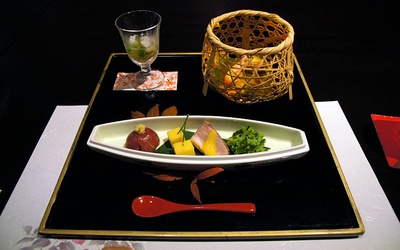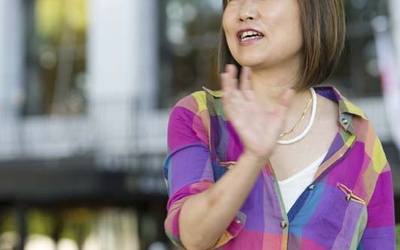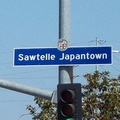
Yukikazu Nagashima
Born in Chiba City and graduated from Waseda University. In 1979, he moved the U.S. He worked at California Daily Newspaper and joined the Japanese editorial team at The Rafu Shimpo in 1984. In 1991, he became Editor of the Japanese department. He left the company in August, 2007. In September of the same year, he received an award by the Consulate-General of Japan in Los Angeles. He has published a series of articles titled “Profile of Nikkei Contemporary History” in TV Fan introducing the Japanese and nikkei in America. Currently he works as an editor of “J-Town Guide Little Tokyo,” a community magazine in English which introduces Little Tokyo.
Updated August 2014
Stories from This Author
The Rise and Fall of Kobayakawa Boarding House—Mr. Ishioka Recognizes the Value in the Naming of Japantown
Nov. 7, 2017 • Yukikazu Nagashima
Today, in the open area on the east side of Sawtelle Boulevard, from La Grange Avenue to Missouri Avenue, stand big complex facilities and apartment buildings. In that block, there used to be a boarding house where many gardeners lived. It was called “Kobayakawa Boarding House.” It was a large boarding house with six big premises and simple frame houses that once held 60 people at its peak. Riichi Ishioka, an immigrant from Hiroshima started the business in a solitary …
To “Chinchikurin”
March 17, 2017 • Yukikazu Nagashima
“I want Caucasians to eat it.” Chinchikurin—Hiroshima okonomiyaki restaurant on Sawtelle Boulevard Finding a parking spot on a street in Sawtelle on a Friday night is such a hassle. After going around the place twice in search for a spot, I was finally able to find one on La Grange Avenue, two blocks west of Sawtelle Boulevard. I parked my car there and walked to Sawtelle Boulevard. Heading south from Sawtelle Boulevard, I saw neon lights on a variety of …
Hashimoto Nursery: Yotaro Hashimoto Keeps His Business Going
Aug. 25, 2016 • Yukikazu Nagashima
The Sawtelle district is located in West Los Angeles. In 2015, it was officially named “Sawtelle Japantown” by the Los Angeles City Council, and a sign was placed at the corner of Sawtelle and Olympic. For a long time the area had been known as Little Osaka, due to the large number of shops and restaurants owned by Japanese Americans. Local residents and shop owners established an advocacy organization and worked hard to get their neighborhood recognized. They are overjoyed …
I Want to Spread Traditional Tattoos: Horitomo – The Japanese Tattooist in America - Part 2
Oct. 23, 2015 • Yukikazu Nagashima
Read Part 1 >> To America About four years later, as he had gained more experience and his training seemed to be going smoothly, Horitomo thought about what he would be doing in the future: then he imagined himself in 15 years. As he worked as a tattooist, he came to understand more deeply about how tattoos are seen in Japan and how the Japanese society had dealt with tattoos. And in such a society, he would be working as …
I Want to Spread Traditional Tattoos: Horitomo – The Japanese Tattooist in America - Part 1
Oct. 22, 2015 • Yukikazu Nagashima
I have a book here. It’s an English book titled Monmon Cats. Readers can find pictures of cats tattooed with a variety of Japanese designs throughout the 118 pages of this book. The writer is a tattoo artist by the name of Horitomo, originally from Mie Prefecture, Japan, who now works in San Jose, California. For those who don’t know that the word “Monmon” is another name for tattoo, perhaps the book title would sound completely unfamiliar. However, in this …
Truth of Tattoo Keeps Me Alive – A Personal Letter to Junko Shimada
July 23, 2014 • Yukikazu Nagashima
I decided to write a letter to you so that in the process, I could better understand what you told me when I visited your tattoo parlor the other day. Your story gave me courage. It might have been because I myself, coincidentally, was feeling down at the time for some personal reason. But still, I’m sure that your story will give courage to others, just like it did to me—even just to one person. I just hope that it …
UNESCO “Japanese Food : Intangible Cultural Heritage”
Feb. 5, 2014 • Yukikazu Nagashima
UNESCO (The United Nations Educational, Scientific and Cultural Organization) decided to register “Washoku” (traditional Japanese cuisine) as an Intangible Cultural Heritage1 on December 4, 2013 during the intergovernmental panel at Azerbaijan, Baku. That was recommended by the Japanese government. Until now Gastronomy Art of France, Mediterranean Cuisine, Traditional dishes of Mexico, and Traditional kashkak of Turkey have been registered as Intangible Cultural Heritage, but the food culture of the country as a whole having been recognized as Intangible Cultural Heritage …
柳田由紀子著 『二世兵士 激戦の記録』 証言で綴る第二次世界大戦
March 12, 2013 • Yukikazu Nagashima
ロングビーチ市在住のジャーナリスト、柳田由紀子さんの新著「二世兵士 激戦の記録─日系アメリカ人の第二次大戦」(新潮新書、2012年7月刊)が好評だ。売上は好調で、増刷の話も出ている。日系兵士に関する書籍はいろいろ出ているが、特定の個人や部隊に焦点を当てたものが多い中で、柳田さんの新著は、真珠湾攻撃、強制収容から従軍、戦後の日本占領、そして朝鮮戦争と、二世の戦争についての全容を示す「通史」となっている。それは、総勢約150人の証言を基にして綴られた歴史であり、そこには数々のド…
About My Father, Yoshitaro Amano – Memories from the eldest daughter, Hamako - Part 4 of 4
July 31, 2012 • Yukikazu Nagashima
Part 3 >>Endless MemoriesHamako endlessly recalls memories of her father. They include sides of Amano that only she may know of. Amano went from Akita to Yokohama and had struggled quite a bit. He attended a technical school hoping to become a shipyard engineer, but dropped out just prior to graduation. Therefore, there is no record of his education in his resume. And then, of course, there were his endeavors abroad. Even after the war, he became the first Japanese …
About My Father, Yoshitaro Amano – Memories from the eldest daughter, Hamako - Part 3 of 4
July 24, 2012 • Yukikazu Nagashima
Part 2 >>Amano’s MarriageSpeaking of marriages, there is an episode about Amano’s marriage to Miyoko that allows us to take a glimpse into his character. Hamako and Harry left Japan in 1950, and this story takes place four years later. A year after Hamako’s departure, Amano left Japan once again in 1951 and headed for Peru. Since he was blacklisted by the US, he couldn’t obtain a passport, so he tried to get to Panama by way of Canada—but officers …













